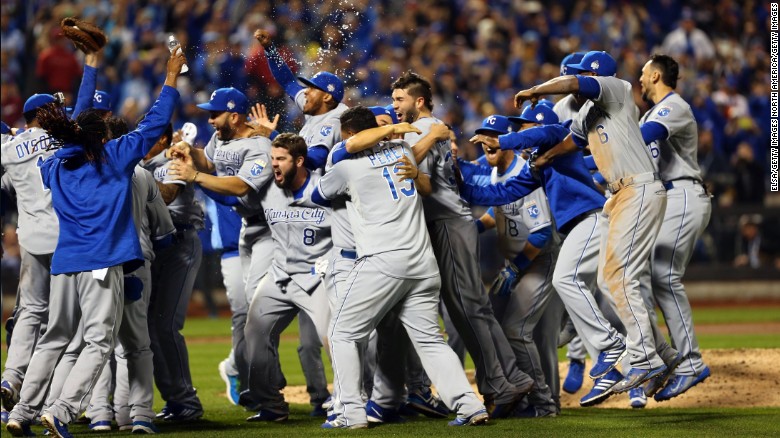Kansas City Royals win the World Series defeating the NY Mets as patience and building through the draft finally pay off:
Via: Yahoo Sports
It took nine seasons, but Dayton Moore’s “process” finally worked. The Kansas City Royals have won the 2015 World Series.
Early in his tenure, Moore told fans to “trust the process,” referring to the way in which he was building the team. It took years, but eventually that process produced a championship.
That means, in the coming days, weeks and months, there will be a number of articles suggesting other teams should emulate the Royals. This isn’t a new development, these types of pieces always get published shortly after a team wins a World Series. Just ask Theo Epstein.
“The only thing I know for sure,” Cubs president Theo Epstein said Monday, “is that whatever team wins the World Series, their particular style of play will be completely en vogue and trumpeted from the rooftops by the media all offseason — and in front offices — as the way to win.”
What’s particularly interesting about the Royals is that their style of play is extremely unique, especially in today’s game.
Most teams are built on power and patience at the plate. You want home run hitters who can get on base. And if they can’t do both of those things, they should be able to do at least one. If they happened to strike out a lot but provide one of those skills, that’s absolutely fine. Strikeouts are just another out, mostly. No different than a fly out to left, or a ground out to third. On the mound, you want strikeouts. You want that ace who is going to punch out nearly a batter per inning. Pitchers are throwing harder than ever, and matchups in the bullpen are stressed more now than in the past. Strikeout rates, among both hitters and pitchers, are at an all-time high.
The Royals, as constructed, are pretty much built to counter all of that. At the plate, the team eschewed power and patience in favor of a contact-oriented approach. The Royals ranked 24th in home runs during the regular season and had a 6.3 percent walk rate, which tied for dead last.
The team’s 15.9 percent strikeout rate, however, ranked first in the league. This aided them in a number of ways. The Royals not only made contact better than every other team, but they weren’t as susceptible to dominant pitching due to their approach. That is definitely important in the playoffs, when teams have to face a murderer’s row of Clayton Kershaw, Zack Greinke, Jake Arrieta, Jon Lester, Matt Harvey, Noah Syndergaard and Jacob deGrom in consecutive games.
The Royals did plenty of other things well, of course. They mostly built through the draft, had a strong defense and assembled a lights out bullpen. We know building through the draft is beneficial at this point, and we’ve already seen articles on teams trying to build strong defenses or great bullpens on the cheap.
For that reason, it’s the contact-oriented approach that stands out for Kansas City. When writers draw up their think pieces on whether other teams should build like the Royals, it will be the team’s approach at the plate that gets mentioned the most.
It doesn’t seem like a bad strategy based on many of the reasons we’ve already outlined. And though the Royals didn’t hit a ton of home runs, and weren’t a strong on-base team, they still ranked seventh in the league with 724 runs scored. That contact-oriented approach worked.
Problem is, the Royals were able to assemble these types of players on the cheap. Many of the team’s prominent players were drafted by Kansas City, and are either arbitration-eligible, or signed cheap deals that buy out some of their arbitration years. Alex Gordon, Eric Hosmer, Mike Moustakas, Lorenzo Cain and Salvador Perez all fit in this category.
The Royals main free-agent adds were Kendrys Morales, a power hitter who doesn’t strike out as much as you might think, and Alex Rios. Morales was coming off a down year, and was seen as a buy-low candidate. It’s tough to justify the Rios deal, even after you adjust for some of his playoff heroics. During the season, the team brought in Ben Zobrist, another low-strikeout guy. That only cost them a few minor prospects.
The point is, the Royals didn’t have to go out and spend millions in free agency to get these guys. Even when they found guys they liked on the market, they didn’t have a pay a ton because contact hitting wasn’t necessarily a skill that was sought after.
